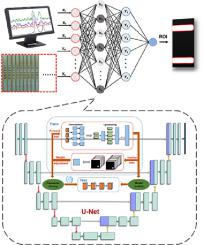Journal of Chromatography A ( IF 3.8 ) Pub Date : 2020-11-05 , DOI: 10.1016/j.chroma.2020.461680 Qi Qin , Kan Wang , Hao Xu , Bo Cao , Wei Zheng , Qinghui Jin , Daxiang Cui

|
Lateral flow immunoassay (LFIA) is one of the most common methods in point-of-care testing, which is widely applied in some conditions for various applications. Image segmentation is an increasingly popular experimental paradigm to efficiently test the target area in LFIA. However, due to process pollution, and problems related to the experimental operation and irregular structure of the background of the reaction, currently available tools cannot be used to extract correct signals from these images, which affects the accuracy of detection. Machine learning has significantly improved modern biochemical analysis by pushing the limits of traditional techniques for the recognition and processing of images. In this paper, the U-Net, a variant of the convolutional neural network (CNN) is used for the quantitative analysis of LFIA images for the accurate quantification of single- and multi-target images. By graying, binarizing, and labeling different concentrations of test strips, the target area of LFIA images containing the T-/C-lines is extracted and obtained. Then it provides updated trends and directions for the development of LFIA technology. Several indicators are introduced to evaluate the proposed U-Net structure to verify the feasibility and effectiveness of its image processing capability. When the trained U-Net model was used to process images, the peak signal-to-noise ratio was 22.4 dB, significantly higher than prevalent methods in the area that have reported only a 4 dB improvement in the quality of the graphics. The intersection-over-union between samples also increased to above 93%. Our results show that the proposed method has significant potential for detecting a segmented target in an LFIA area, especially weak positive signals and multichannel detection. With other modifications, this deep learning method can be applied as a powerful tool to study rapid detection devices, systems, and biological images.
中文翻译:

对色谱数据进行深度学习以进行细分和敏感分析
横向流动免疫测定法(LFIA)是即时检验中最常用的方法之一,在某些条件下广泛应用于各种应用。图像分割是一种越来越流行的实验范例,可以有效地测试LFIA中的目标区域。但是,由于过程污染以及与实验操作和反应背景的不规则结构有关的问题,当前可用的工具不能用于从这些图像中提取正确的信号,这影响了检测的准确性。机器学习通过突破传统技术在图像识别和处理方面的局限性,极大地改善了现代生化分析。在本文中,U-Net 卷积神经网络(CNN)的一种变体用于LFIA图像的定量分析,以准确定量单目标和多目标图像。通过对不同浓度的测试条进行灰化,二值化和标记,可以提取并获得包含T- / C线的LFIA图像的目标区域。然后,它为LFIA技术的发展提供了最新的趋势和方向。引入了一些指标来评估建议的U-Net结构,以验证其图像处理功能的可行性和有效性。当使用训练有素的U-Net模型处理图像时,峰值信噪比为22.4 dB,大大高于该地区报告的图形质量仅提高4 dB的流行方法。样本之间的交叉相交也增加到93%以上。我们的结果表明,该方法具有检测LFIA区域中分割目标的巨大潜力,尤其是弱阳性信号和多通道检测。通过其他修改,这种深度学习方法可以用作研究快速检测设备,系统和生物图像的强大工具。











































 京公网安备 11010802027423号
京公网安备 11010802027423号